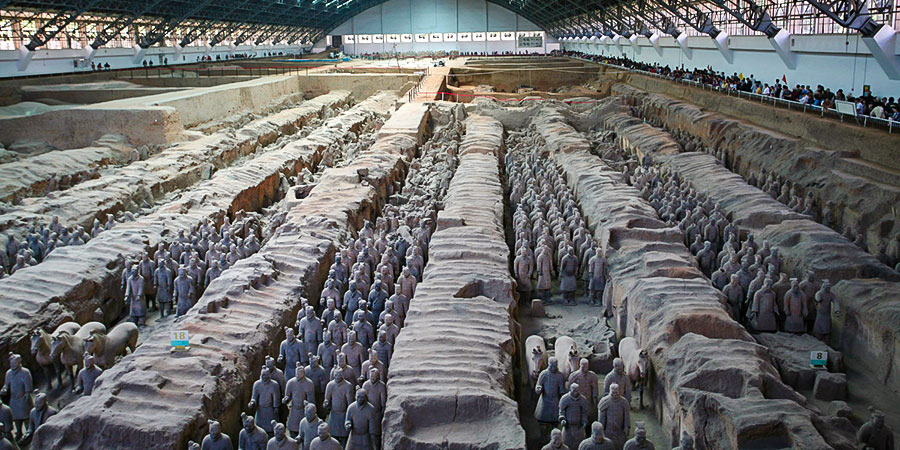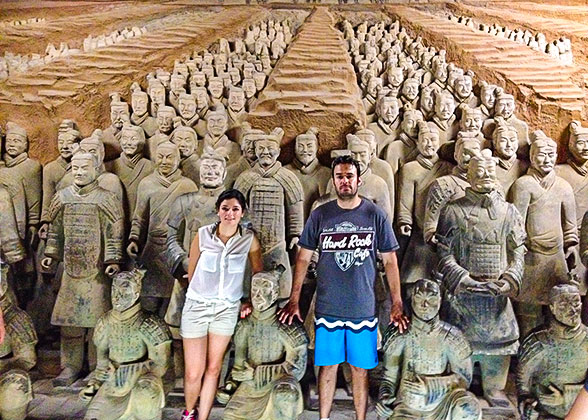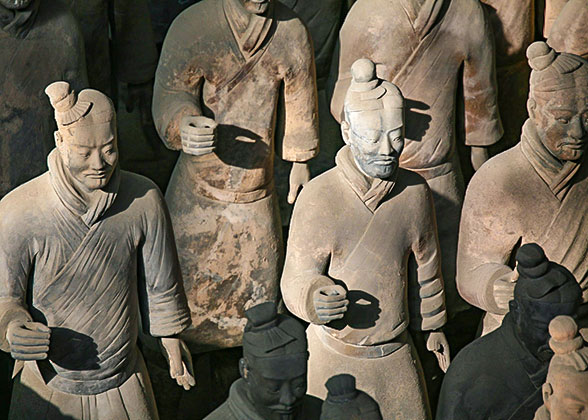Top 20 Questions about Terracotta Army
FAQs on Terracotta Warriors and Horses
![]() 1. What are the Terracotta Warriors?
1. What are the Terracotta Warriors?
![]() Those terracotta soldiers are life-sized pottery figures made about 2,200 years ago as military army to defend Qin Shi Huang - the First Emperor of China in his afterlife. They were unveiled to the world in March 1974.
Those terracotta soldiers are life-sized pottery figures made about 2,200 years ago as military army to defend Qin Shi Huang - the First Emperor of China in his afterlife. They were unveiled to the world in March 1974.
![]() 2. Where are the Terracotta Warriors?
2. Where are the Terracotta Warriors?
![]() They are displayed in the three pits of the Museum of Qin Terracotta Warriors and Horses, near Xi'an City, Shaanxi Province.
They are displayed in the three pits of the Museum of Qin Terracotta Warriors and Horses, near Xi'an City, Shaanxi Province.
 |
| Panoramic View of Pit 1 |
![]() 3. Who Built the Terracotta Warriors?
3. Who Built the Terracotta Warriors?
![]() They were constructed by millions of laborers, under the order of Emperor Qin Shi Huang. His Prime Minister, Li Si, was appointed as the designer and director, and Zhang Han, a general then, was the construction supervisor.
They were constructed by millions of laborers, under the order of Emperor Qin Shi Huang. His Prime Minister, Li Si, was appointed as the designer and director, and Zhang Han, a general then, was the construction supervisor.
![]() 4. How old is the Terracotta Army? When was it made?
4. How old is the Terracotta Army? When was it made?
![]() The Terracotta Army was at the age of over 2,200. Upon ascending the throne, Qin Shi Huang ordered the construction of his mausoleum together with the underground army. at around 247BC or 246BC. The whole process lasted nearly 40 years adn stopped at 208BC.
The Terracotta Army was at the age of over 2,200. Upon ascending the throne, Qin Shi Huang ordered the construction of his mausoleum together with the underground army. at around 247BC or 246BC. The whole process lasted nearly 40 years adn stopped at 208BC.
![]() 5. Why are the Terracotta Warriors important?
5. Why are the Terracotta Warriors important?
![]() First, they are the funeral objects of Qin Shi Huang, the first emperor in China's history. They can help to discover the funeral art of ancient China.
First, they are the funeral objects of Qin Shi Huang, the first emperor in China's history. They can help to discover the funeral art of ancient China.
Second, the warriors and horses give a clue of China's military development in the Qin Dynasty (221 - 207 BC).
Third, they manifest the highly skillful sculpture art of China 2,200 years ago, providing materials for studying the ancient Chinese civilization.
![]() 6. Why was the Terracotta Army built? What was the purpose of the Terracotta Warriors?
6. Why was the Terracotta Army built? What was the purpose of the Terracotta Warriors?
![]() There are two popular reasons. Firstly, it is said that Qin Shi Huang was a worshipper of superstition. He believed that people could still enjoy all they owned after death. Therefore, he had the Terracotta Army made to safeguard, accompany and serve him in the afterlife. Secondly, all these were sacrificial objects. As he was an emperor, he demanded to have more magnificent sacrificial things.
There are two popular reasons. Firstly, it is said that Qin Shi Huang was a worshipper of superstition. He believed that people could still enjoy all they owned after death. Therefore, he had the Terracotta Army made to safeguard, accompany and serve him in the afterlife. Secondly, all these were sacrificial objects. As he was an emperor, he demanded to have more magnificent sacrificial things.
![]() 7. How were the Terracotta Warriors made?
7. How were the Terracotta Warriors made?
![]() There are 7 steps to complete an integrated pottery figurine: first, make its main body from the pedestal to the collar with yellow earth; then use the mould to make head, arms, and hands, next; glue them together and let it dry in the shade; carving the details and getting them fired in kilns are the following two steps. At last, after installing head, the Terracotta Warriors need to be glazed and colored.
There are 7 steps to complete an integrated pottery figurine: first, make its main body from the pedestal to the collar with yellow earth; then use the mould to make head, arms, and hands, next; glue them together and let it dry in the shade; carving the details and getting them fired in kilns are the following two steps. At last, after installing head, the Terracotta Warriors need to be glazed and colored.
![]() 8. How were Shi Huangdi's Terracotta Warriors discovered? When, where and by whom were they discovered?
8. How were Shi Huangdi's Terracotta Warriors discovered? When, where and by whom were they discovered?
![]() In March, 1974, when some peasants of Xiyang Village, currently a part of Terracotta Army Village or Xiahe Village were digging a well, they found some pottery pieces. Archeologists who quickly went there to extend the digs declared them to be of great value. Later the amazing treasures were presented. In 1975, the government decided to build a museum at the site for protection and further research.
In March, 1974, when some peasants of Xiyang Village, currently a part of Terracotta Army Village or Xiahe Village were digging a well, they found some pottery pieces. Archeologists who quickly went there to extend the digs declared them to be of great value. Later the amazing treasures were presented. In 1975, the government decided to build a museum at the site for protection and further research.
See also: Who found the Terracotta Warriors?
![]() 9. How many Terracotta Warriors are there?
9. How many Terracotta Warriors are there?
![]() According to the latest statistics, more than 8,000 terracotta figures and horses are laid out in three pits in the museum, including infantry warriors, cavalry warriors, archers and chariot warriors as well as war chariots and horses.
According to the latest statistics, more than 8,000 terracotta figures and horses are laid out in three pits in the museum, including infantry warriors, cavalry warriors, archers and chariot warriors as well as war chariots and horses.
 |
| See Size of Terracotta Warriors from the Replicas |
![]() 10. How tall are the Terracotta Warriors?
10. How tall are the Terracotta Warriors?
![]() Generally, they are life-size or a little taller. Specifically, they average 1.73-1.96 m (5.7-6.4 ft) and the tallest one is around 2.5 m (8.2 ft).
Generally, they are life-size or a little taller. Specifically, they average 1.73-1.96 m (5.7-6.4 ft) and the tallest one is around 2.5 m (8.2 ft).
![]() 11. Which direction does the terracotta army face? Why?
11. Which direction does the terracotta army face? Why?
![]() All the pottery warriors are facing east. According to historical records, the original ruling area of Qin was in the west and the other states were in the east. Qin Shi Huang always planned to unify all states, so the soldiers and horses facing east might confirm his determination for unification. Some people think that they were made to face east to keep close attention to the movements of the eastern states, ready to fight them at any time.
All the pottery warriors are facing east. According to historical records, the original ruling area of Qin was in the west and the other states were in the east. Qin Shi Huang always planned to unify all states, so the soldiers and horses facing east might confirm his determination for unification. Some people think that they were made to face east to keep close attention to the movements of the eastern states, ready to fight them at any time.
![]() 12. I heard that all the warriors are different. Is that true?
12. I heard that all the warriors are different. Is that true?
![]() Yes, they are all different. Over 720,000 artisans and common laborers had been involved in the construction. They made some parts by hand and even the parts made by mold would later be carved by hand for details, leading to the pottery figures being all different. Also, the hairstyle, clothes, postures and equipment for soldiers of various types and ranks are different, which also lead to their individuality.
Yes, they are all different. Over 720,000 artisans and common laborers had been involved in the construction. They made some parts by hand and even the parts made by mold would later be carved by hand for details, leading to the pottery figures being all different. Also, the hairstyle, clothes, postures and equipment for soldiers of various types and ranks are different, which also lead to their individuality.![]() See more about
See more about
Faces of Terracotta Warriors
Hairstyles of Terracotta Warriors
Types of Terracotta Warriors
![]() 13. I heard the Terracotta Warriors were first made in delicate colors. Is it true?
13. I heard the Terracotta Warriors were first made in delicate colors. Is it true?
![]() Yes, it is true. They were originally painted and the major colors were scarlet, rose-bengal, pink, purplish red, dark blue, green, and reddish brown. However, because of the current defective protective technology, they are immediately oxidized and become drab when being unearthed. Thus the protection of the magnificent historical project is still a challenge in archaeology.
Yes, it is true. They were originally painted and the major colors were scarlet, rose-bengal, pink, purplish red, dark blue, green, and reddish brown. However, because of the current defective protective technology, they are immediately oxidized and become drab when being unearthed. Thus the protection of the magnificent historical project is still a challenge in archaeology. ![]() See more about True Colors of Terracotta Warriors
See more about True Colors of Terracotta Warriors
![]() 14. Has the Mausoleum of Qin Shi Huang been fully excavated?
14. Has the Mausoleum of Qin Shi Huang been fully excavated?
![]() No. The Terracotta Army is just part of it. The underground palace of the Mausoleum of Qin Shi Huang is still in mystery. Because of the limited contemporary excavation technologies and difficulty level of the mausoleum excavation, it is not possible to fully excavate it at present.
No. The Terracotta Army is just part of it. The underground palace of the Mausoleum of Qin Shi Huang is still in mystery. Because of the limited contemporary excavation technologies and difficulty level of the mausoleum excavation, it is not possible to fully excavate it at present.
FAQs on How to Visit Terracotta Army
![]() 15. Where is the Terracotta Army? How far is the museum from Beijing?
15. Where is the Terracotta Army? How far is the museum from Beijing?
![]() It is located in the Lintong District of Xi'an, Shaanxi Province, around 40km (25mi) from Xi'an city center, and around 1,100km (684mi) from Beijing.
It is located in the Lintong District of Xi'an, Shaanxi Province, around 40km (25mi) from Xi'an city center, and around 1,100km (684mi) from Beijing.![]() See more about How to Get to Terracotta Army from Beijing/ Shanghai/ Hong Kong
See more about How to Get to Terracotta Army from Beijing/ Shanghai/ Hong Kong
 |
| Delicate Terracotta Figures |
![]() 16. How to Get to Terracotta Army from Downtown Xi'an?
16. How to Get to Terracotta Army from Downtown Xi'an?
![]() From downtown Xi'an, you can take metro line 9 to Huaqing Pool Station, and then transfer to Lintong Bus 602 to the Terracotta Army; or take direct tourist No. 5 (306) from Fangzhicheng Bus Station; or take bus 307 inside the city or a taxi to reach the Terracotta Warriors and Horses. The taxi fare from Xi'an Railway Station or the city center area to the museum is about CNY 150.
From downtown Xi'an, you can take metro line 9 to Huaqing Pool Station, and then transfer to Lintong Bus 602 to the Terracotta Army; or take direct tourist No. 5 (306) from Fangzhicheng Bus Station; or take bus 307 inside the city or a taxi to reach the Terracotta Warriors and Horses. The taxi fare from Xi'an Railway Station or the city center area to the museum is about CNY 150.
From the airport, you can hire a taxi directly to the museum with a fare of CNY 150 - 200. You can also take the airport shuttle bus to Xi'an University of Science and Technology, and then change to Lintong Bus 602, or tourist bus line 5 (306) to the museum.
From Xi'an North Railway Station, you can take metro line 2 to Beidajie and transfer to metro line 1 to Fangzhicheng. Then, take metro line 9 to Huaqing Pool Station and change to Lintong Bus 602 to get to Terracotta Warriors and Horses Museum.
![]() 17. What is the best time to visit Terracotta Warriors Museum?
17. What is the best time to visit Terracotta Warriors Museum?
![]() The best months for a visit should be March to May and September to October because of the pleasant weather. To enjoy a comfortable tour, you are advised to avoid holidays, when the scenic site is full of visitors. The best times to visit the Terracotta Army are prior to 10:00 a.m. and lunchtime in early afternoon.
The best months for a visit should be March to May and September to October because of the pleasant weather. To enjoy a comfortable tour, you are advised to avoid holidays, when the scenic site is full of visitors. The best times to visit the Terracotta Army are prior to 10:00 a.m. and lunchtime in early afternoon.
![]() 18. How long does it take to see the Terracotta Warriors?
18. How long does it take to see the Terracotta Warriors?
![]() Three to four hours are recommended to visit the museum.
Three to four hours are recommended to visit the museum.
![]() 19. Is photography allowed?
19. Is photography allowed?
![]() Yes, it is allowed. However, for well preservation of earthen figurines, you should not use the camera's flashlight when photographing them.
Yes, it is allowed. However, for well preservation of earthen figurines, you should not use the camera's flashlight when photographing them.
![]() 20. Can I jump into the pits to take a photo with terracotta warriors and horses?
20. Can I jump into the pits to take a photo with terracotta warriors and horses?
![]() No, you cannot do that. There is warning board that reads "No Admittance" inside the terracotta warriors pits. As tourists, you are not allowed to climb over the fencing around the pits to take photographs with those pottery warriors and horses.
No, you cannot do that. There is warning board that reads "No Admittance" inside the terracotta warriors pits. As tourists, you are not allowed to climb over the fencing around the pits to take photographs with those pottery warriors and horses.